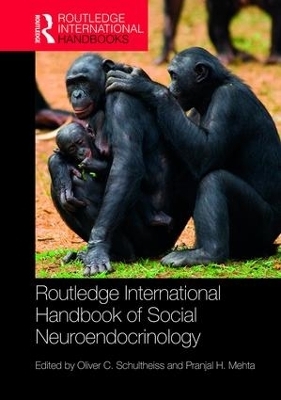
Routledge International Handbook of Social Neuroendocrinology
Routledge (Verlag)
978-1-138-71144-0 (ISBN)
The Routledge International Handbook of Social Neuroendocrinology is an authoritative reference work providing a balanced overview of current scholarship spanning the full breadth of the rapidly developing field of social neuroendocrinology. Considering the relationships between hormones, the brain, and social behavior, this collection brings together groundbreaking research in the field for the first time.
Featuring 39 chapters written by leading researchers, the handbook offers impressive breadth of coverage. It begins with an overview of the history of social neuroendocrinology before discussing its methodological foundations and challenges. Other topics covered include state-of-the-art research on dominance and aggression; social affiliation; reproduction and pair bonding (e.g., sexual behavior, sexual orientation, romantic relationships); pregnancy and parenting; stress and emotion; cognition and decision making; social development; and mental and physical health. The handbook adopts a lifespan approach to the study of social neuroendocrinology throughout, covering the role that hormones play during gestation, childhood, adolescence, and adulthood. It also illustrates the evolutionary forces that have shaped hormone-behavior associations across species, including research on humans, non-human primates, birds, and rodents.
The handbook will serve as an authoritative reference work for researchers, students, and others intrigued by this topic, while also inspiring new lines of research on interactions among hormones, brain, and behavior in social contexts.
Oliver C. Schultheiss is a Professor of Psychology at Friedrich-Alexander University, Erlangen, Germany. His research focuses on the implicit motivational needs for power, achievement, affiliation, and sex, and their interactions with the endocrine system. Pranjal H. Mehta is Senior Lecturer in Experimental Psychology at the University College London. His research examines interactions between hormones, the social environment, and human behavior with an emphasis on status hierarchies, stress, and decision making.
List of contributors
Introduction
Oliver C . Schultheiss and Pranjal H . Mehta
SECTION 1 Historical and methodological issues
1 History of social neuroendocrinology in humans
Allan Mazur
2 Hormone measurement in social neuroendocrinology : a comparison of immunoassay and mass
spectrometry methods
Oliver C. Schultheiss , Gelena Dlugash, and Pranjal H . Mehta
3 Reproducibility in social neuroendocrinology : past, present, and future
Oliver C . Schultheiss and Pranjal H. Mehta
SECTION 2 Dominance and aggression
4 Leveraging seasonality in male songbirds to better understand the neuroendocrine regulation of vertebrate aggression
Douglas W . Wacker
5 Behavioral and neuroendocrine plasticity in the form of winner and loser effects
Nathaniel S Rieger, Matthew J . Fuxjager, Brian C . Trainor, Xin Zhao, and Catherine A. Marler
6 The endocrinology of dominance relations in non-human primates
Sean P . Coyne
7 The dual-hormone approach to dominance and status-seeking
Amar Sarkar, Pranjal H . Mehta, and Robert A . Josephs
8 Social neuroendocrinology of human aggression : progress and future directions
Justin M . Carré, Emily Jeanneault, and Nicole Marley
SECTION 3 Social affiliation
9 Social endocrinology in evolutionary perspective : function and phylogeny
Nicholas M . Grebe and Steven W . Gangestad
10 Organizational and activational effects of progesterone on social behavior in female mammals
Alicia A . Walf and Cheryl A . Frye
11 The neuroendocrinological basis of human affi liation : how oxytocin coordinates affiliation-related cognition and behavior via changing underlying brain activity
Bastian Schiller and Markus Heinrichs
12 Oxytocin and human sociality: an interactionist perspective on the “hormone of love”
Jonas P. Nitschke, Sonia A. Krol, and Jennifer A. Bartz
13 Affi liative or aggressive? The role of oxytocin in antisocial behaviour through the lens of the social salience hypothesis
Leehe Peled-Avron and Simone G. Shamay-Tsoory
SECTION 4 Pair bonding, reproduction, and parenting
14 Functional roles of gonadal hormones in human pair bonding and sexuality
James R . Roney
15 Organizational effects of hormones on sexual orientation
Kevin A. Rosenfield , Khytam Dawood , and David A. Puts
16 Hormones and close relationship processes: neuroendocrine bases of partnering and parenting
Robin S. Edelstein and Kristi Chin
17 The many faces of human caregiving : perspective on flexibility of the parental brain, hormonal systems, and parenting behaviors and their long-term implications for child development
Eyal Abraham and Ruth Feldman
18 The social neuroendocrinology of pregnancy and breastfeeding in mothers (and others)
Jennifer Hahn-Holbrook and Colin Holbrook
19 The neuroendocrinology of fatherhood
Patty X . Kuo and Lee T . Gettler
SECTION 5 Cognition and emotion
20 Sex hormonal effects on brain lateralization
Markus Hausmann and D. Michael Burt
21 Estrogens and androgens in the prefrontal cortex : relevance for cognition and decision-making
Elizabeth Hampson
22 Sex hormones and economic decision making in the lab: a review of the causal evidence
Anna Dreber and Magnus Johannesson
23 Emotional processing and sex hormones
Malin Gingnell, Jonas Hornung, and Birgit Derntl
24 Hormonal modulation of reinforcement learning and reward-related processes – a role for 17ß-estradiol, progesterone and testosterone
Esther K. Diekhof, Luise Reimers, and Sarah K. C. Holtfrerich
25 The impact of psychosocial stress on cognition
Oliver T . Wolf
26 Intra- and interindividual differences in cortisol stress responses
Sandra Zänkert and Brigitte M . Kudielka
SECTION 6 Developmental aspects
27 Stress and social development in adolescence in a rodent model
Travis E . Hodges and Cheryl M. McCormick
28 Oxytocin and vasopressin systems in the development of social behavior
Elizabeth A. D . Hammock
29 The social neuroendocrinology and development of executive functions
Rosemarie E . Perry, Eric D . Finegood, Stephen H . Braren, and Clancy Blair
30 Sensitive periods of development and the organizing actions of gonadal steroid hormones on the adolescent brain
Kalynn M. Schulz and Zoey Forrester-Fronstin
31 The social biopsychology of implicit motive development
Martin G. Köllner, Kevin T. Janson, and Kira Bleck
32 Interventions, stress during development, and psychosocial adjustment
Leslie E . Roos, Kathryn G. Beauchamp, Jessica Flannery, Sarah Horn, and Philip A. Fisher
33 Developmental trajectories of HPA–HPG dual-axes coupling: implications for social neuroendocrinology
Ellen Zakreski, Andrew Richard Dismukes, Andrea Tountas, Jenny Mai Phan, Shannin Nicole Moody, and Elizabeth Ann Shirtcliff
SECTION 7 Mental and physical health
34 Neuroendocrinological aspects of social anxiety and aggression-related disorders
Dorien Enter, Moniek H. M . Hutschemaekers, and Karin Roelofs
35 The social neuroendocrinology of trauma and post-traumatic stress disorder
Amy Lehrner and Rachel Yehuda
36 Attachment and depression: is oxytocin the shared link?
Allison M. Perkeybile and C. Sue Carter
37 Sexual dimorphism in drug addiction: an influence of sex hormones
Linda I . Perrotti, Brandon D. Butler, and Saurabh S . Kokane
38 Neuroendocrine–immune interactions in health and disease
Nicolas Rohleder
39 The social neuroendocrinology of athletic competition
David A . Edwards and Kathleen V. Casto
Index
| Erscheinungsdatum | 15.10.2018 |
|---|---|
| Reihe/Serie | Routledge International Handbooks |
| Zusatzinfo | 11 Tables, black and white; 80 Illustrations, black and white |
| Verlagsort | London |
| Sprache | englisch |
| Maße | 174 x 246 mm |
| Gewicht | 1387 g |
| Themenwelt | Geisteswissenschaften ► Psychologie ► Biopsychologie / Neurowissenschaften |
| Medizin / Pharmazie ► Medizinische Fachgebiete | |
| Naturwissenschaften ► Biologie ► Genetik / Molekularbiologie | |
| Naturwissenschaften ► Biologie ► Humanbiologie | |
| Naturwissenschaften ► Biologie ► Zoologie | |
| ISBN-10 | 1-138-71144-6 / 1138711446 |
| ISBN-13 | 978-1-138-71144-0 / 9781138711440 |
| Zustand | Neuware |
| Informationen gemäß Produktsicherheitsverordnung (GPSR) | |
| Haben Sie eine Frage zum Produkt? |
aus dem Bereich


